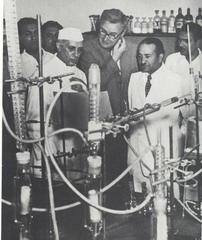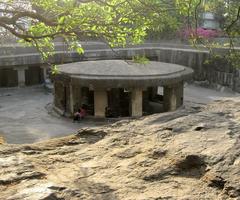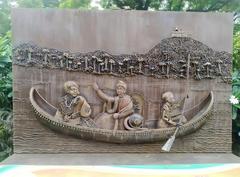Pune Tribal Museum: Visiting Hours, Tickets, and Complete Guide to Pune’s Tribal Heritage
Date: 04/07/2025
Introduction
The Pune Tribal Museum, located in the heart of Pune, Maharashtra, is a vital institution celebrating the state’s rich and diverse indigenous heritage. Established in 1962 as an extension of the Tribal Research and Training Institute (TRTI), the museum showcases the cultural, artistic, and social traditions of Maharashtra’s tribal communities. With an extensive collection of artifacts, immersive displays, and educational programs, the museum provides visitors with a unique opportunity to understand and appreciate the lives of the Bhil, Warli, Gond, Madia, and many other tribal groups (Pune Mirror; Museums of India; Maharashtra Tourism).
This comprehensive guide covers the museum’s origins, its role in preserving tribal heritage, detailed visitor information, and tips for making the most of your trip, including nearby Pune historical sites.
Table of Contents
- Introduction
- Origins and Establishment of the Pune Tribal Museum
- Representation of Maharashtra’s Tribal Communities
- Preservation of Material Culture and Artistic Traditions
- Practical Visitor Information
- Cultural Significance and Educational Role
- Impact on Contemporary Identity
- Frequently Asked Questions (FAQ)
- Suggested Visuals and Interactive Elements
- Visitor Recommendations and Conclusion
- References
Origins and Establishment
Founded in 1962 as an initiative of the Tribal Research and Training Institute (TRTI), the Pune Tribal Museum was created to document, preserve, and display the cultural wealth of Maharashtra’s tribal communities (TRTI Official). Under the guidance of visionaries like Dr. Govind Gare, the museum became a hub for tribal empowerment, encouraging artisans to contribute objects and artworks that reflect their everyday lives and beliefs.
The museum is located at 28, Queen’s Garden, near the Old Circuit House, Bund Garden Road, Pune (Museums of India). Its establishment marked a significant step toward integrating tribal culture into the broader narrative of Maharashtra’s heritage.
Representation of Maharashtra’s Tribal Communities
The museum is dedicated to showcasing the traditions of Maharashtra’s major tribal groups, including the Bhil, Pawara, Mavchi, Mahadeo Koli, Madia, Gond, Warli, and others (Pune Mirror). Key sections include:
- Tribes at a Glance Art Gallery: Displays portraits and artifacts from each tribe, offering insights into their daily lives, rituals, and social structure.
- Outdoor Tribal Huts: Full-scale models of tribal huts immerse visitors in indigenous architectural techniques and domestic arrangements (Museums of India).
Preservation of Material Culture and Artistic Traditions
The museum’s collection is a testament to the creativity and resourcefulness of Maharashtra’s tribal peoples. Highlights include:
- Ornaments and Jewelry: Intricately crafted metal and bead ornaments, such as those from the Madia and Bhil tribes.
- Musical Instruments: Drums, flutes, and stringed instruments central to tribal festivals and ceremonies.
- Warli Paintings: Celebrated geometric art from Thane and Nashik, including early works by Jivya Soma Mashe, which brought international recognition to Warli art (Pune Mirror).
- Ritual Masks and Festival Objects: Bohada masks used in religious performances, and symbolic items like the Hichadi comb and Chhibli basket, each with their own cultural significance.
The museum also features agricultural implements, bamboo crafts, and household utensils, reflecting the communities’ adaptation to their environments.
Practical Visitor Information
Visiting Hours
- Tuesday to Sunday: 10:00 AM – 5:00 PM
- Closed: Mondays and public holidays
- Hours may vary during special events; check the TRTI official website for updates.
Tickets and Entry Fees
- Indian Adults: ₹20 (some references note ₹10; verify at source)
- Children and Senior Citizens: ₹10
- Foreign Tourists: ₹200 (rates may vary)
- Students: Discounted rates available with ID
- Photography: Allowed in most galleries with prior permission; flash and tripods may be restricted
Accessibility and Facilities
- Wheelchair accessible entrances and galleries
- Restrooms adapted for visitors with disabilities
- Audio guides and brochures in multiple languages
- Museum shop offering tribal crafts and publications
How to Reach the Museum
- Address: 28, Queen’s Garden, Bund Garden Road, Pune
- Public Transport: Close to Pune Railway Station (approx. 3 km); well-connected by city buses, taxis, and auto-rickshaws
- By Air: Pune International Airport is about 10 km away
Nearby Attractions
Combine your museum visit with these Pune historical sites:
- Shaniwar Wada: The iconic Maratha fortification
- Aga Khan Palace: A landmark of India’s freedom struggle
- Raja Dinkar Kelkar Museum: Renowned for its collection of art and artifacts
- Osho Ashram and MG Road: For spiritual and shopping experiences
Special Events and Guided Tours
- Regular cultural festivals, art workshops, and exhibitions
- Guided tours and documentary screenings available on request
- Educational workshops for school and college groups
Cultural Significance and Educational Role
The museum plays a crucial role in promoting social integration, cultural understanding, and pride among tribal communities (Pune Mirror). It acts as a center for research, housing a library and archives supporting academic work in anthropology and ethnography (Museums of India). Collaborations with universities and NGOs amplify its impact on cultural studies, policy advocacy, and community outreach.
Impact on Contemporary Identity
By celebrating and safeguarding tribal heritage, the museum fosters inclusivity and inspires new generations of artists and cultural practitioners (Factober). It encourages sustainable practices and integrates traditional knowledge into modern cultural production.
Frequently Asked Questions (FAQ)
Q: What are the Pune Tribal Museum’s visiting hours?
A: Tuesday to Sunday, 10:00 AM to 5:00 PM. Closed on Mondays and public holidays.
Q: How much are the tickets?
A: ₹20 for adults, ₹10 for children and seniors. Foreign tourists: ₹200. Student discounts may apply.
Q: Is the museum wheelchair accessible?
A: Yes, with facilities for differently-abled visitors.
Q: Is photography allowed?
A: Yes, with prior permission; flash and tripods may be restricted.
Q: Are guided tours available?
A: Yes, on request. Audio guides and brochures are also provided.
Q: What other attractions are nearby?
A: Shaniwar Wada, Aga Khan Palace, and Raja Dinkar Kelkar Museum.
Suggested Visuals and Interactive Elements
- Images: Entrance of the museum, Warli paintings, tribal jewelry, hut models, and interactive exhibits (alt tags: “Pune Tribal Museum visiting hours,” “Pune Tribal Museum tickets,” “Warli painting display”).
- Virtual Tours: Digital walkthroughs and 360° gallery views.
- Interactive Maps: Highlighting the museum and nearby attractions.
Visitor Recommendations and Conclusion
The Pune Tribal Museum stands as a vibrant testament to Maharashtra’s indigenous heritage, offering a meaningful and educational experience for all visitors. With its affordable entry, accessible facilities, and engaging exhibits, the museum is ideal for families, students, and travelers alike. For the best experience:
- Plan your visit on a weekday to avoid crowds
- Check the museum’s official channels for updates on events and ticketing
- Explore nearby historical sites to enrich your Pune cultural journey
Stay informed by following the museum on social media and using the Audiala app for curated tours and latest updates. Your visit supports the ongoing preservation and celebration of Maharashtra’s tribal heritage.
References
- Pune Mirror, 2024, Take a Peek Into Maha Tribal Life
- Museums of India, 2024, Tribal Cultural Museum
- Maharashtra Tourism, 2024, Pune Tribal Museum
- Tribal Research & Training Institute (TRTI), 2024, About Museum
- Factober, 2024, Discovering the Rich Cultural Heritage of Pune




